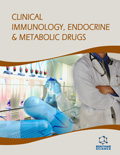Abstract
Insulin resistance is linked to the actions of glucose oxidized low-density lipoprotein (GLDL) and tumour necrosis factor alpha (TNF-a). Minocycline (M) has documented antioxidant effects. This study investigates the yield of 5-a dihydrotestosterone (DHT) as a marker of redox healing in MG63 osteoblasts in response to TNF-a, glucose (G), G+LDL, M and their combinations. Confluent monolayer cultures of MG63 osteoblasts were incubated with radiolabelled testosterone as substrate and optimal concentrations of TNF-a, G, GLD+L, minocycline and their combinations in multiwell plates for 24h (n=8). The medium was eluted and solvent extracted for metabolites. They were separated by TLC, in a benzene acetone solvent system (4:1 v/v) and quantified using a radioisotope scanner. There were significantly reduced yields of DHT in response to TNF-a, G, G+LDL and their combinations, overcome by M to values significantly above controls (n=8; p<0.001). The other metabolites 5a-androstane-3b, 17b-diol (diol) and 4-androstenedione showed similar and inverse trends to those of DHT respectively. Oxidative responses to glucose, glucose oxidised low density lipoproteins and TNF-a in osteoblasts were overcome by the antioxidant effects of minocycline. MG 63 osteoblasts in culture are a useful model for extrapolating these findings to periodontitis and associated chronic inflammatory diseases.
Keywords: Chronic inflammation, glucose oxidized LDL, glucose, minocycline, osteoblasts, TNF-α.
Graphical Abstract
 29
29

